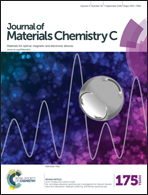The effects of donor : acceptor intermolecular mixing and acceptor crystallization on the composition ratio of blended, spin coated organic thin films†
Abstract
In this work, we used poly(3-hexylthiophene) (P3HT) as the donor and four different perylene diimide (PDI) acceptor molecules as model systems used in blended, spin cast thin films. We analyzed the change in the composition ratio of P3HT with respect to each PDI compound in films compared to the composition ratio of their parent solutions. The PDI molecules varied by the length of the branched side group moieties that are attached at the imide N-positions. The lengthening of these side chains hinders thin film crystallization. When P3HT is blended with the smallest branched side chain PDI, a 71% decrease in the donor : acceptor molar ratio is obtained while this ratio changes by 9% when P3HT is blended with the largest branched side chain PDI. Atomic force microscopy (AFM) and X-ray diffraction measurements confirm that the crystal structures of the PDI acceptor materials decrease as the length of the side chains increase. We attribute the change in the donor : acceptor ratios in these films to phase separation and aggregation effects. Smaller PDI molecules form larger crystals in the films, which enhances the acceptor interaction with the substrate. In contrast, PDI molecules with longer side chains exhibit better miscibility with the P3HT donor molecules, which reduces substrate–acceptor interactions and produces more uniform films. As a result of these effects, the films containing PDI molecules with longer side chains have composition ratios more similar to the casting solutions from which they were made.



 Please wait while we load your content...
Please wait while we load your content...